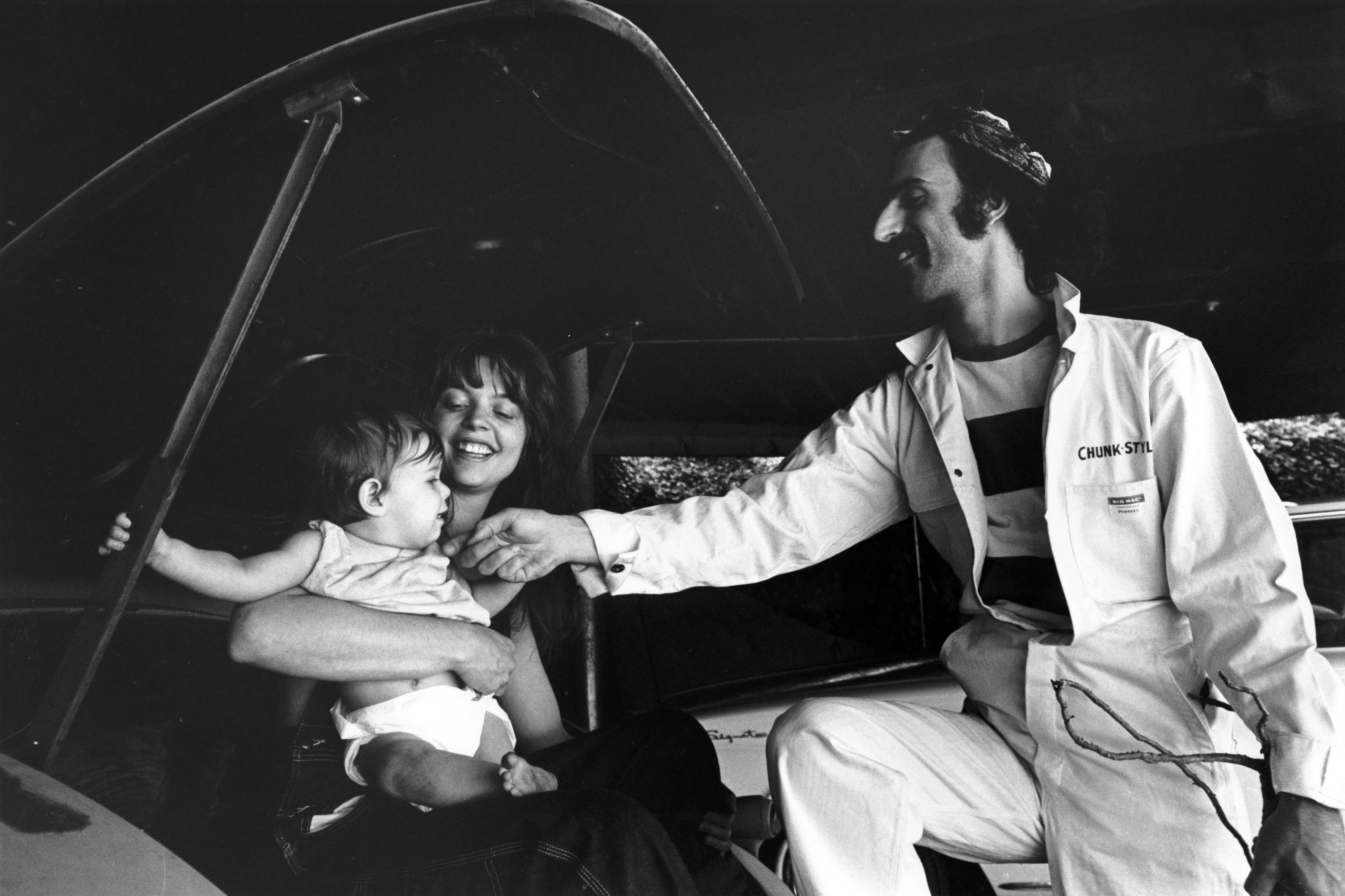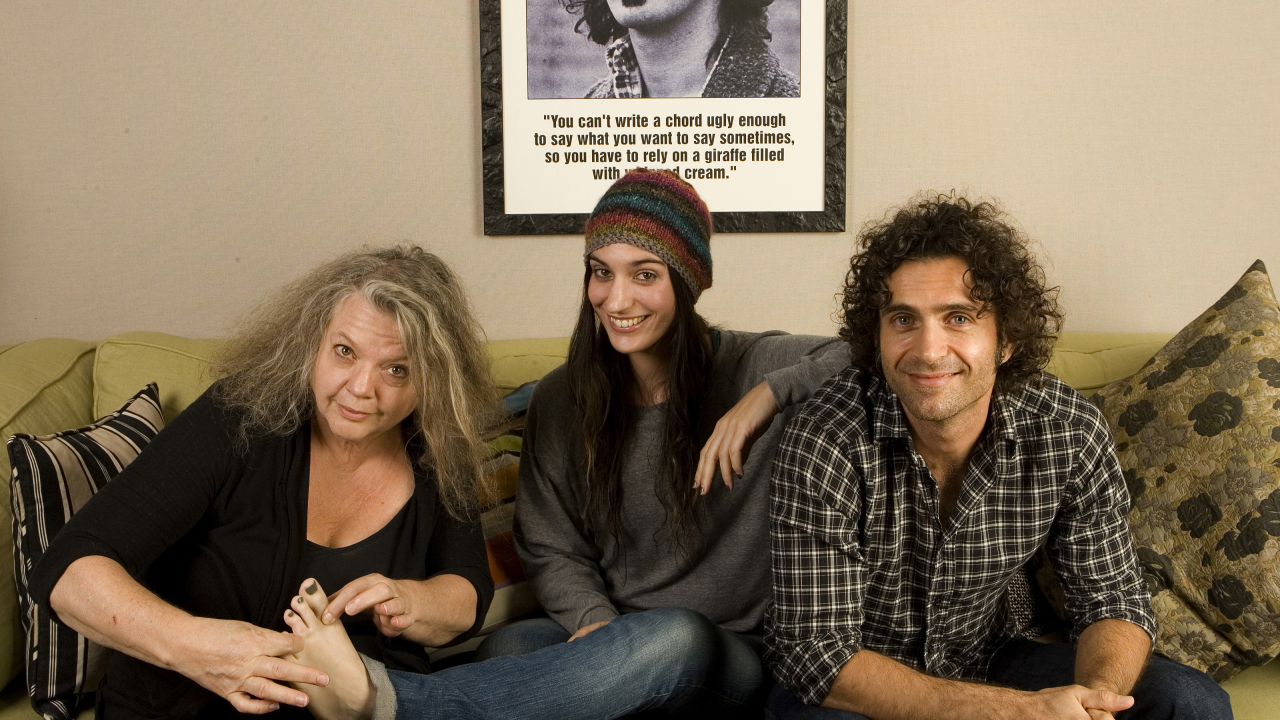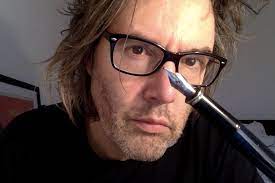I was lucky enough to meet Gail Zappa a handful of times, though it’s the first and last meeting that stay with me the most. I was interviewing Dweezil Zappa in Disneyland in 1991. It was Dweezil’s idea, I was on assignment or Kerrang! magazine at the time and Dweezil thought that the combination of a heavy metal magazine, as was, and the happiest place on earth would be as good a starting point for an interview as any.
It was the Namm guitar convention and the whole place was abuzz at the news that Frank Zappa (and David Lee Roth) alumni, Steve Vai was to play his first live solo show in support of his acclaimed Passion And Warfare album. Gail liked Steve well enough, he’d been more than kind to Dweezil when he was younger and worshipped at the feet of Frank, but she was only there that day to keep an eye on her kid. I remember recognising her smile from the photographs - that toothy grin - and no one was more surprised than me, (well, maybe the PR and Dweezil) when I stood bolt upright mid-interview to reach over and shake her hand. What can I tell you, I was a Zappaphile, still am.
Fast forward to November 2010 and the basement of the Roundhouse venue in Camden, north London, Gail sat across from me, that same laugh, the same smile. Her daughter Diva was sat in the cafe bar the floor above and one storey above that was Dweezil and his Zappa Plays Zappa band sound-checking their way through Apostrophe ahead of that night’s show. She was happy to talk about anything on the condition that I gave her an mp3 copy of our interview for the autobiography she had loosely planned for sometime in the future. We talked, naturally, about her husband and their son and the things, ultimately, she still missed about Frank. And she left me, still full of dignity and grace, with this:
“He used to leave wet towels all over the bathroom floor”, she said, “It used to drive me nuts, but, you know, I’d give anything now just to have those wet towels back again.“
The official Zappa website, in a statement from her family, sums up her legacy best: ”Gail will forever be identified as a key figure in the creative renaissance that is Laurel Canyon, but more than any singular accomplishment, she defined herself in her personal relationships, happiest when surrounded by loved ones and artists, often one in the same. The memories she leaves behind are indeed her own art form. Her searing intelligence, unforgettable smile, wild thicket of hair and trailing black velvets leave a blur in her wake.”
The tea-drinking Gail Zappa caught on camera in one of Frank’s home movies.
In Issue #41 of Prog Magazine, Sid Smith caught up with Gail and Dweezil Zappa to talk about Frank’s enduring musical and philosophical legacy
Over a bowl of brown rice, John Lennon and Tony Palmer are enjoying a bit of a natter and a catch-up. The pair had first met back in 1963 when Palmer, as a reporter for the Cambridge University magazine, interviewed the Fab Four when they were playing the city. Lennon had been keen to have a look around the place, but of course Beatlemania precluded such a walkabout. Donning a disguise, the incognito Beatle was shown around Cambridge’s architectural delights by a delighted Palmer. Before rejoining his bandmates, Lennon handed the Moral Sciences student a piece of paper with a telephone number on it, saying, “If you’re ever in London give me a call.”
Spooling forward to 1967, Palmer, now an up-and-coming director at the BBC, called the number and, much to his surprise, Lennon arranged a date for dinner. As they ate, Lennon leaned forward conspiratorially: “Now that you’re making TV programmes it’s your duty to make a show about all the musicians who either can’t get onto the BBC or don’t want to do Juke Box Jury or Top Of The Pops.” He handed Palmer another piece of paper. This time there was a list of names and at the top of it was Frank Zappa.
Aired on the BBC in 1968, the resulting documentary, All My Loving, was one of the first credible attempts to examine pop music as a means of social commentary and a vehicle for opposition to the political orthodoxies of the day. Palmer, who later worked with Zappa on the movie version of 200 Motels, thought him one of the most intelligent and articulate rock musicians he’d come across. It’s tempting to view the bands participating in the documentary as all being part of some liberal consensus about the ills of the day and the potential solutions. Yet even at this relatively early stage in his career, Zappa was largely removed from contemporaries such as The Beatles, Cream, The Who, et al, both musically and politically.

A famous contrarian, Zappa was utterly scathing of the Summer Of Love, the corporate manipulation of youth and the manifestations of ‘hippie’, the so-called alternative culture that proliferated at the time, viewing it as plastic and self-serving.
“Pop music is sitting there pretending it’s going to grow and any minute going to turn into something,” he scornfully told the press in 1967, the same year he recorded Who Needs The Peace Corps?, his scorching satire on the scene and the drug culture in general: ‘Every town must have a place / Where phony hippies meet / Psychedelic dungeons / Popping up on every street / GO TO SAN FRANCISCO…’
In the 20 years that have passed since his death from prostate cancer in 1993, interest in Zappa’s music has never been higher, resonating just as much as it did in his lifetime thanks to an ongoing series of back-catalogue reissues and a steady release of archive material directly from his family’s extensive vaults. Since 2006, his son, Dweezil, has fronted Zappa Plays Zappa, touring extensively with a mission to bring his father’s music not only to die-hard fans but to a new generation of younger listeners. In 2012, there were large-scale orchestral presentations of 200 Motels on both sides of the Atlantic. And in an irony Zappa himself would have relished, an orchestral score of his was performed at this year’s Proms at the Royal Albert Hall, the same venue which banned him in 1971, on the grounds that his graphic brand of rock’n’roll was an affront to taste and decency.
“The fact that Frank is described as a rock’n’roll artist is about as Dada as you could get,” argues his widow, Gail Zappa. “There was no other classification for what he did at the time he emerged so that’s what they called him. If you look at what he did in rock’n’roll and you compare that with his orchestral music, you’ll find the same kinds of changes, the same kinds of experimental versions of what is possible with an orchestra and what is happening with rock’n’roll instrumentation. For Frank there was no difference. He used the same compositional technique throughout.”
Life-changing events come in all shapes and sizes, and usually from unexpected sources. For the teenage Frank in mid-1950s California, it was the day he haggled with a record-store owner for an album by Edgard Varèse, containing the composition Ionisation. Zappa had previously read about the piece in a magazine and was intrigued. The New Yorker’s Alex Ross described Varèse and other ultra-modernist composers of the day as pursuing a kind of “radical dissonance”, quoting Varèse as saying he wasn’t searching for the Holy Grail so much as “the bomb that would make the musical world explode and thereby let in all sounds, sounds which up to now – and even today – have been called noises”.
The particular bomb that exploded Frank’s world, which up to then had included a love of rhythm and blues and some early school-dance gigs as a drummer, threw him into an odd and abrasive percussive landscape. Strange and alien, he was utterly transfixed by the indefinable timbre and texture within the piece. As perplexing as it was, it was also an environment in which he felt at home, where he knew he belonged. Zappa recounted that, for months on end, *Ionisation *held him spellbound. Hijacking the family’s record player, he obsessively immersed himself in Varèse’s world while his mother, as he put it, “looked at me like I was out of my fucking mind.”
There’s a picture from 1970 of Zappa and his parents, Francis and Rosemary, posed for an edition of Life Magazine. Of Sicilian/Italian descent, they sit on a sofa in Zappa’s plush LA home, looking out of place next to their now famous son, who stands apart. Even allowing for the artificiality, it expresses a distance between parents and celebrated offspring.
“I would not say that they were close,” says Gail Zappa, who married Frank in 1967. “I think on the one hand you have a very strong Sicilian sensibility culturally surrounding Frank’s father, whose whole background was being involved with people that were Sicilian or Italian. Frank grew up in that world but… I don’t think he was in synch with a certain kind of culture that’s very drawn from tradition. Frank knew from a very early age and he just wasn’t going to buy into any of these concepts. Even when he was nine, he’d already invented a way of expressing himself that he was very comfortable with. It didn’t matter what other people thought, he was going to go ahead and do his own thing.”

She suspects that, though his parents didn’t know what to make of his success and notoriety, Frank probably got his penchant for marketing from his father “I remember once when Frank gave the family car back to his parents so his brother could have it, his father tried to sell the car as ‘formerly driven by Frank Zappa’. What they got for it, I have no idea,” she guffaws.
There’s a deep irony in the way Zappa has been placed as an icon of stoner culture, something which in practice he despised. It irritated Frank during his lifetime and rankles his son, Dweezil, today.
“Rolling Stone not so long ago printed an illustration of Frank with a lit joint. Now, he was clearly not a guy who was involved in drugs. He was always telling people not to do drugs. So they print some stupid thing like that. Clearly they had to make a drawing of it because no such photo like that would ever exist. It’s just dumb. Like they’re trying to perpetuate this myth. It’s real easy for people who don’t know anything about his music to just say, ‘he’s the wacky guy with the kids with the wacky names, and he must have been on drugs…’ but it’s just irresponsible of Rolling Stone to perpetuate that myth when the truth is exactly the opposite.”
One imagines that, for such an incredibly driven individual, working and touring more or less full-time must have taken a toll on family life. “What is a normal family life? I don’t know how to say, ‘What normal life?’” offers Gail. “The closest I can get to explaining that is that people often ask me, well, what did Frank and I talk about, and I guarantee you the word ‘mortgage’ never came up.”
Dweezil, born in 1969, when Frank recorded the landmark Hot Rats, confirms his father was exceptionally driven. “As an 11-year-old kid he went to the library and he decided he wanted to become a composer and he taught himself everything about writing music from reading books. He didn’t have formal training as a composer or conductor, so he taught himself in his own auto-didactic style. Throughout his life he was certainly a busy guy but you have to try to imagine how somebody can make 80 albums in less than 40 years and have the kind of variety of music that’s written on there,” says Dweezil.
“He still had the ability to focus on things and adapt to life as a father, so it’s not like we didn’t get any time with him whatsoever. Every family has their own sense of what’s normal, so for us… we didn’t have that celebrity privileged lifestyle. It wasn’t anything like that. Even then, when Frank was still touring and making records, it wasn’t like he was this massively well-known celebrity.”
Exposure to Frank’s unconventional music from an early age undoubtedly impacted on Dweezil’s own musical tastes. “When I grew up listening only to my dad’s music as a kid, I didn’t really hear anything else from the radio until I was probably about 11 or 12 years old. Then when I did hear that other stuff, my first thought was, ‘Where’s the rest of it? Where are all the other instruments? Where’s all the detail?’”
Attention to detail very much exercised the composer. There are stories attesting to how, in his quest for perfection, he could rub people up the wrong way. Not known to suffer fools gladly, was he a hard man to please? “Not necessarily, but he knew what was possible and when people were cutting corners or not giving their best effort then he’d be disappointed or frustrated,” argues Dweezil.
The range of Zappa’s output is breathtaking and sometimes bafflingly diverse. There’s Zappa the doo-wop singer; the contemporary classical composer; the jazz-rock maestro; the avant-garde modernista; the blues player par excellence; the full-on satirist; the rock guitarist’s guitarist; the purveyor of knockabout adolescent silliness and forensically detailed pastiche, as well as sounds and styles which resist easy categorisation.
Were his back catalogue to lie on the psychiatrist’s couch, it would be easy to conclude with a diagnosis of multiple personality. Yet as contrasting and cussedly awkward as a lot of it is, it doesn’t sound like anyone else. Though some of the subject matter and humour has dated, the bulk of his output burns with a fierce brilliance. “Not only is his music contemporary,” says Dweezil, “it’s from the future!”
Given that the quantity and breadth is arguably unrivalled, it’s possible to lose oneself in Zappa’s strange and eclectic world. “One thing I know from my years on this planet is that there are no ex-Zappa fans,” says Gail. “Once you get it, you’re in for the duration.”
For more on the great man, not least the mark he left on the 70s, then click on the link below.

